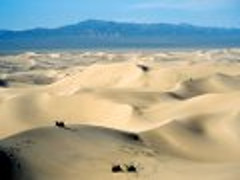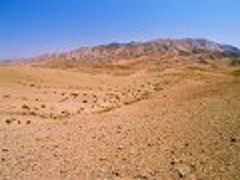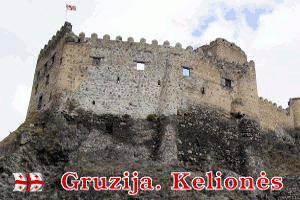Mongolian deserts. The Gobi desert. Information
The Gobi desert Mongolian: Говь, Govi. A large desert covers parts of southern Mongolia (approx. one third of its teritory) and parts of northern and northwestern China. Desert's name comes from the Mongolian word "gov" - a place without water. One of the largest desert in the world are bounded by the Mongolian Altai Mountains, Khangai mountains and the grasslands and steppes of Mongolia on the north, by the Niansian, the Altyntag mountains ranges, Tibetan Plateau, the Hexi Corridor and the North China Plain to the south. Lenght of desert is approx. 1500 km, widh approx 800 km. The Gobi covers approx. 1,295,000 sq.km area
Almost the entire southern part of Mongolia, thousands of kilometers of vastness, like a gigantic tapes extends a mountain ranges. It is the Gobi. The Gobi occupies the entire southern part of Mongolia, as well as a significant area of China. On the maps it is still marked as "desert", although it is not the whole correct. First af all- the precipitations in the Gobi falls not so little: 200-300 milimeters per year, almost one and a half to two times more than in the "classics" deserts. Arisen to 900-2000 meters the Gobi also has cold winters. Second, the name Gobi includes several completely different climate, vegetation and soil regions. Mongolians do not consider the Gobi as single territory - there are even 33 different areas: Salt marsh, Beatific, Yellow and other areas.
A large plains of the Gobi, overgrown by saxaul changes mountains ridges, there is almost no area is covered with sand. Sand dunes occupy only 3% of the territory of the Gobi, and clayey and stony desert (Gamad) occupy large areas. A large parts of the Gobi consists a steppe valleys, rocky mountains, stony or clay gamad's, wide depressions with a few oases, salt pans and takirs. Despite the dry climate in the desert yuo can find clean water, rich wildlife world.
 |
 |
 |
| The Gobi desert. Clay gamad | Sand dunes in the Gobi desert | The Gobi desert. Clay gamad |
The climate of the Gobi is one of great extremes, combined with rapid changes of temperature of as much as 35 °C. These can occur not only seasonally but within 24 hours.
The Gobi is a cold desert. In winter frost and occasionally snow occurring. Being quite far north, it is located on a plateau 900–1500 metres above sea level, which contributes to its low temperatures. The temperatures can drop to -45°C in winter and rise up to +50°C in summer. An average of approx. 200 millimetres of precipitations (mostly rain) falls annually in the Gobi. Additional moisture reaches the Gobi in winter as snow is blown by the wind from the Siberian Steppes.
The Gobi wildlife rich rare animals. Here grows the plants and animals living in are not found no one other place on Earth. Despite the harsh conditions the desert sustain many animals, including wild camels, black-tailed gazelles (djeirans), Mongolian onagers, several antelope species, marbled polecats, bactrian camels, Mongolian wild ass, sandplovers, many rare reptiles and rodents. until recently there lived the wild Przewalski's horses.
Several large nature reserves have been established in the Gobi, including Gobi Gurvansaikhan National Park, Great Gobi A and B Gobi Strictly Protected Areas.
© J.D.Endriukaitis




